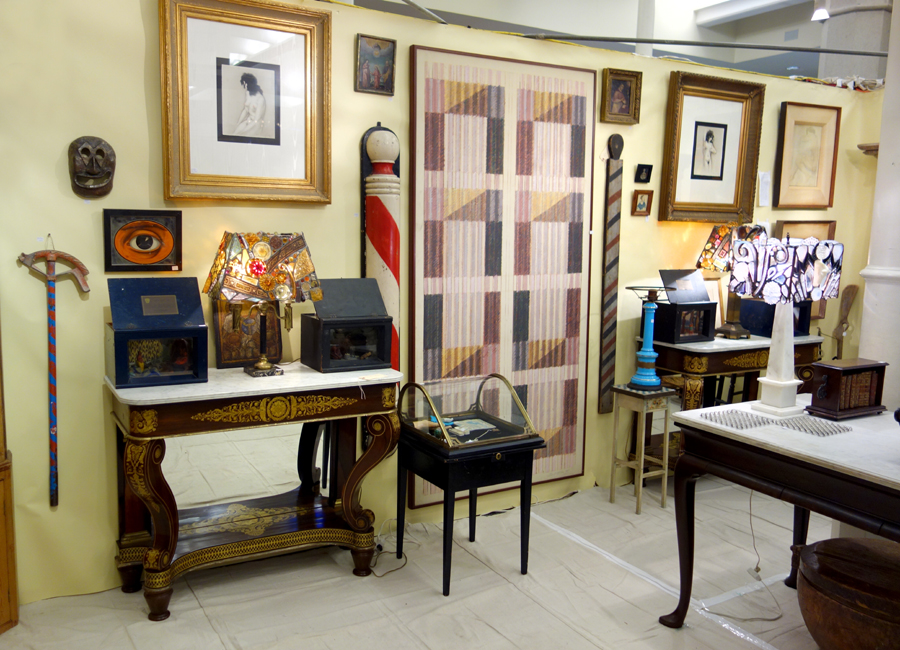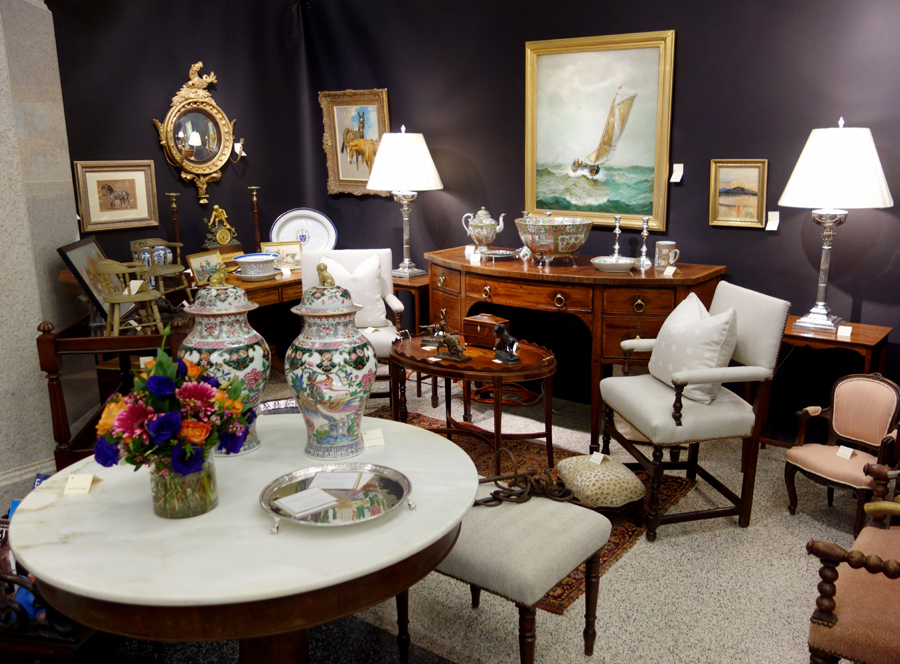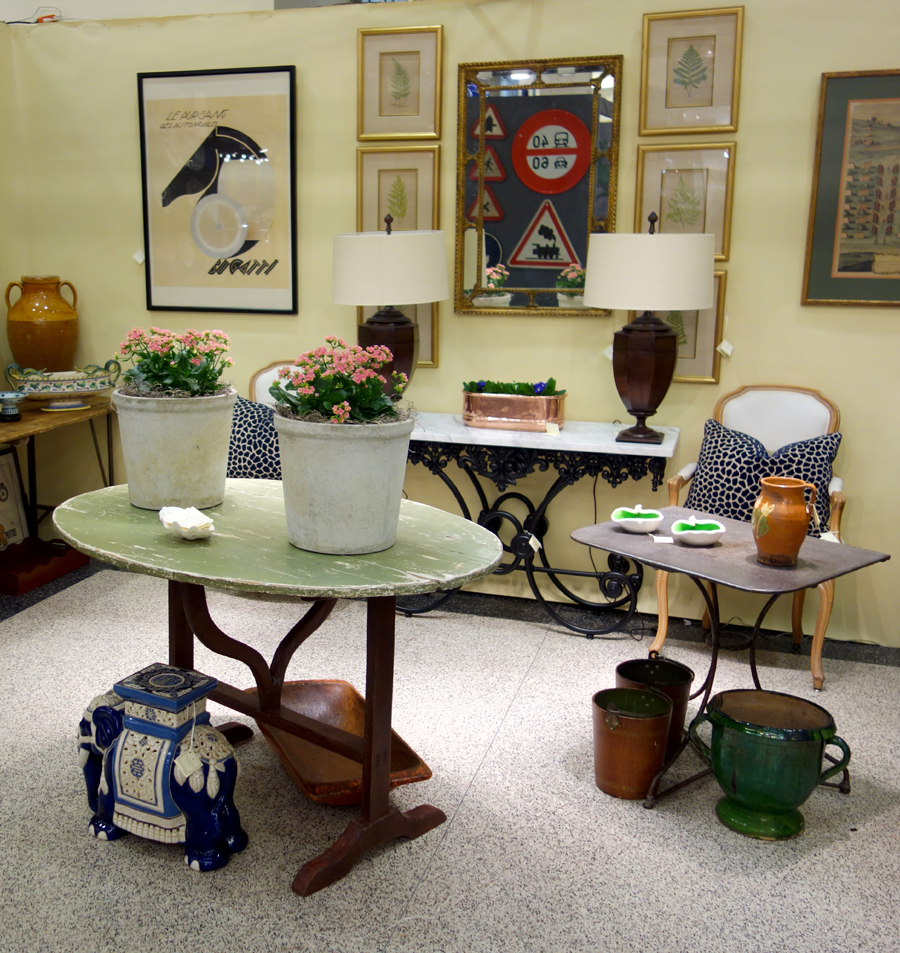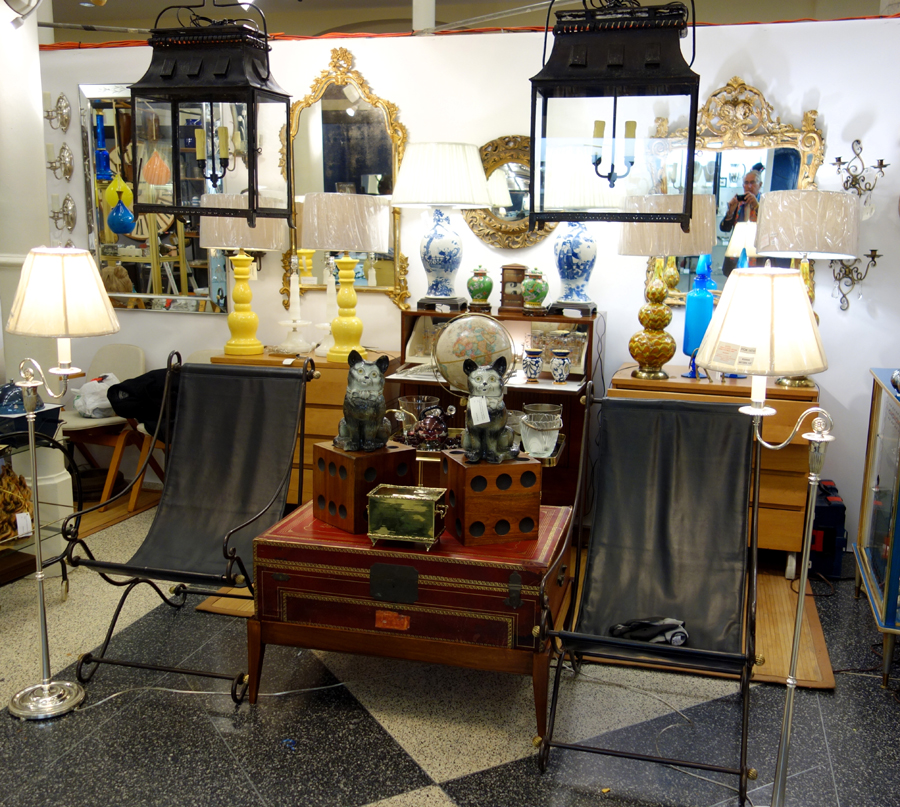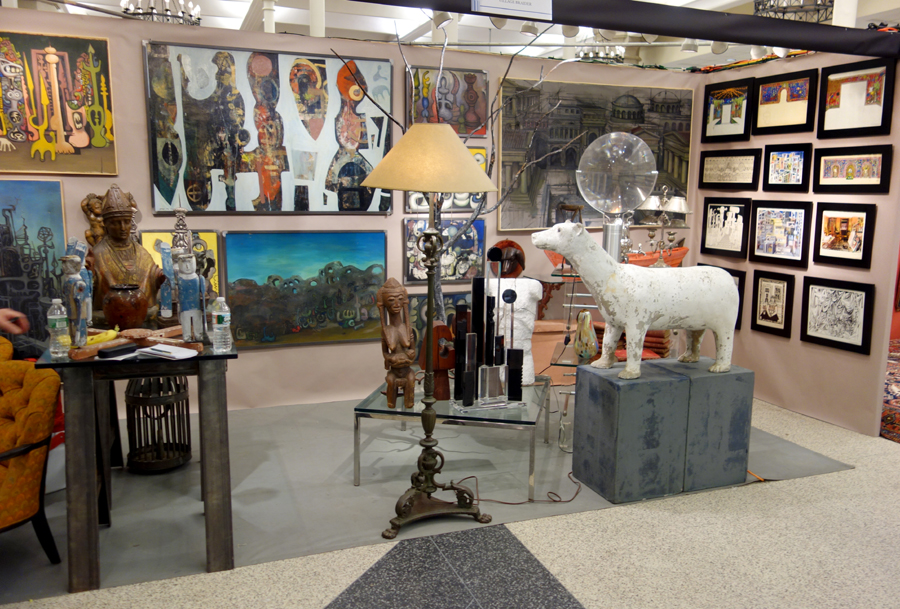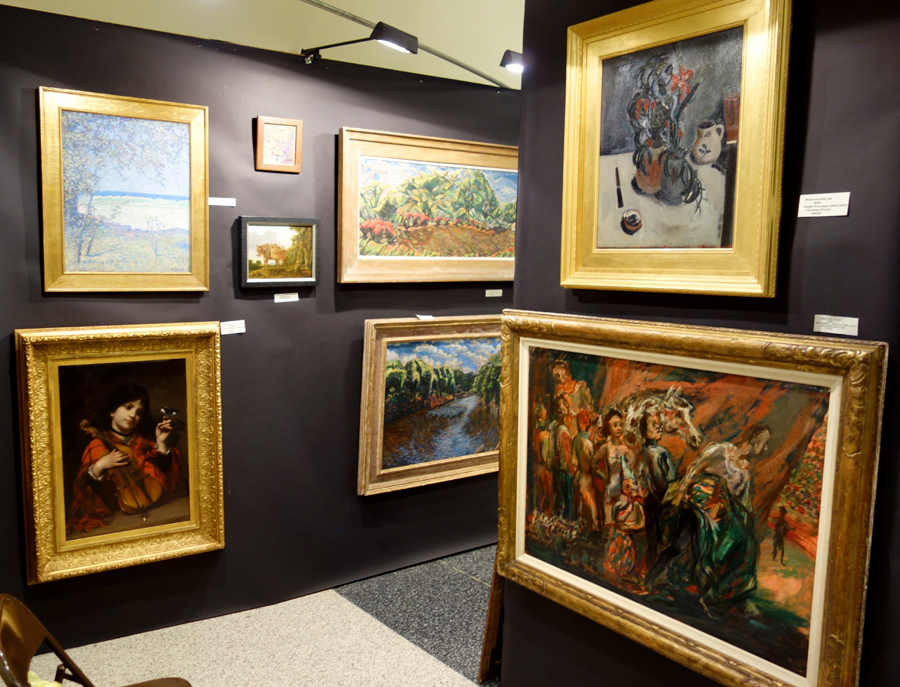Review and Photographs by R. Scudder Smith
NEW YORK CITY — The green awning appeared to be covering a terrace arranged with elegant, circa 1920, Heywood-Wakefield furniture, a setting complete with fresh summer flowers and ice tea glasses arranged on trays, as one entered Wallace Hall, leaving the chill of winter and the second worst snowstorm since 1886 in New York City out on Park Avenue. That warming, welcoming setting was the booth of Antique American Wicker of Nashua, N.H., one of 35 dealers taking part in The Art, Design & Antiques Show. A number of smalls were scattered among the collection of furniture, including a large vase by Crescent & Sons, a bronze sculpture of the Four Seasons, French, dating circa 1880, and a selection of decorated glasses of various sizes.

Brad Reh, show manager, split his time keeping the show running smoothly, greeting visitors and showing jewelry at his booth.
Brad Reh, manager of the show, divided his time greeting visitors at the door, keeping the show running without problems and working his own booth filled with cases of jewelry. “We had a nice opening gate on Friday, but things changed abruptly Saturday morning with the storm that hit the city,” Brad said. He noted, however, that people still trickled into the show in spite of the snow but “we closed the show at 4:30 pm in order for the dealers to get to where they were staying while there was still light.” Sunday, the closing day of the show, “was OK for most of the day and some of the dealers reported having good sales,” Brad added.
The other booth facing the entrance was filled with furniture by Whitehall Antiques of Chapel Hill, N.C., including a French walnut marble top console table, Charles X period, circa 1820, with bold scrolled legs, shaped lower shelf and single drawer, and a French Empire marble top commode, circa 1810, in mahogany with fully developed columns and bronze dore mounts. It had a divided top drawer with swan pulls and measured 36¼ inches high, 51¼ inches wide and 25 inches deep. Among smaller objects shown was a decanter box, French, circa 1860, with brass recessed handles. It contained four Baccarat decanters and four glasses.
An impressive display of tramp art filled the booth of Clifford A. Wallach, Manalapan, N.J., including a bold carved and brightly painted carousel plaque from the Excelsior Amusement Park in Minnesota. Nearby was a whimsy table with quilt top, signed and dated, along with a Picassiette mosaic tramp art stand with secret compartment. The various shapes of smaller pieces filled a showcase and included miniature chests, boxes, including a painted jewelry box with handle, pedestal boxes with finials and a wonderful tramp art carved pocket knife.
A large horse and sulky weathervane filled one of the plinths in the booth of A Bird In Hand, Florham Park, N.J., a piece by Harris & Co., dating from the fourth quarter of the Nineteenth Century. Sitting in one corner of the booth was a wood carved and painted large-size folk art parrot from the first quarter of the Twentieth Century, and an interesting coffee bean dispenser, 32 inches tall, formerly used in a general store, dated circa 1930–40.
A couple of Indian blankets provided bright colors on the walls in the booth of Marcy Burns of New York City. Pottery filled a large table, including a Zuni frog jar, green paint, dating circa 1890–1900, and a Hopi Polacca double canteen of native clay and slip, dated circa 1880–90. A large storage jar, Zia, most probably by Trinadad Medina or Isabel Toribio, dated circa 1920–30.
A pair of carousel giraffes flanked the entrance to the booth of James and Judith Milne, At Home Antiques, Kingston, N.Y., figures that once offered rides at the Storytown USA amusement park, Lake George, N.Y. The life-size carvings dated 1950, retained the original paint and were among the pieces sold at the show. “It was good, considering the circumstances, and we sold a number of things including the two train weathervanes and one horse weathervane we offered,” Judy said. At the front of the booth was a Nineteenth Century cupboard in old blue paint, one door with cabinet space on top, and two large rooster weathervanes included the large version of the Rochester rooster. A portion of the back wall was colorful with a set of brightly painted architectural forms from Pennsylvania, probably Amish, in various shapes, including round, square, triangular and rectangular.
People were welcomed into the booth of The Norwoods’ Spirit of America by a colorful, oval hooked and braided rug with “Welcome” spread across the entire center, where they found a collection of folk art pieces and walls covered with works of art, including a large ship portrait by William Howard Yorke (1847–1921). On a shelf below that oil on canvas was a pair of wood carved and painted penguins, along with three rooster mill weights, all the same small size but in three different colors — red, white and blue.
Bruce Emond, the Village Braider of Plymouth, Mass., was back in step with the antiques business after coming off a knee replacement and filled a large booth with more than two dozen paintings by George Jay Rogers. “This represents close to his life’s work,” Bruce said, “and it was heading for the dumpster when I rescued it.” A large model of a Maine dory, painted bright orange and with one oar, was against the back wall of the booth, and a tin bird cage, tall enough to house a parrot, was shown near a wind toy that held four whirligigs, male figures painted in the original blue and white, with tin hats.
A tramp art set of shelves, about 5 feet tall, 1932 and signed, was painted with green shelves and black and red trim in the booth of Cottage + Camp, Philadelphia. It stood next to a New England decorated Sheraton washstand, and on the back wall a sign, painted on a shield-type board, read “Rooms and Bath.” Three apple baskets, circa 1930 and vividly painted, came out of Woodstock, N.Y.
A few paintings were stacked against the booth walls at From Here To Antiquity, Cheshire, Conn., as the walls were filled to capacity and several pieces of sculpture were displayed on small shelves. Among the paintings were an oil on canvas by Russian American Alexander Dobkin (1908–1975). “Opening Night,” 1941, and “The Little Lake,” a 1940 oil on canvas by New York artist Arthur Schwieder (1884–1965).
Firehouse Antiques, Galena, Md., framed an oil on canvas graphic panel between two barber poles, one half round and painted red and white, the other flat and painted red, white and blue. A pair of handcarved Egyptian columns in solid mahogany were against the side wall, where two chairs were offered, one a full-size ladder back with rush seat, circa 1760, the other a child’s ladder back armchair, also with the original rush seat. Hanging over a slag table was an early sign, white letters on red ground, reading “For Fire Drencher — Stop Valve,” with a double pointed arrow aiming at “On” and “Off.”
Schorr & Dobinsky of Bridgehampton, N.Y., offered an oval wine tasting table dating from the late Nineteenth Century, French, and a large sheet metal weathervane of a horse and rider with top hat, green painted, French, dating from the mid-Nineteenth Century.
Lawrence Farms Antiques & Interiors, Chappaqua, N.Y., showed a pair of white washed cement planters, circa 1940, on a green painted oval top table, and a French baker’s table with iron base and marble top, circa 1920. A French wooden rocking horse, circa 1920, sported a very worn painted surface, attesting to many years of attention for youngsters.
Making the trip from Charleston, S.C., was Julia Santen Gallery with a large quantity of antique posters advertising many different things, including James Bond, the French version, and La Plage De Monte Carlo. Among other topics, transportation was well represented by the Indian motorcycle and the popular Porsche.
Artwork covered the walls at Garvey Rita Art & Antiques, West Hartford, Conn., with paintings by Robert De Niro Sr (1922–1993), “Lilacs in a Yellow Vase,” 1962, an oil on board that measures 30 by 22 inches, and “Dune,” an oil on board, 15 by 14 inches, by Richard Baker, American, born 1959.
“We ran a shuttle between the Winter Show and our show, which proved to be very helpful in getting people about in the snow,” Brad Reh said. He also noted that both the dealers and visitors made the best of weather conditions and many said that they were glad they made the effort and enjoyed the show.
“We are already planning for next year,” Brad said, “and we are hoping for better weather.” He indicated that there may be some turnover in dealers, although, to date, none have indicated that they will not give it another year, and possibly hours will change on opening day. The dates will coincide with the opening weekend of the Winter Antiques Show, a time when the city is abuzz with antiques events.
For additional information, http://rehshows.com or 203-920-1755.
Gallery


